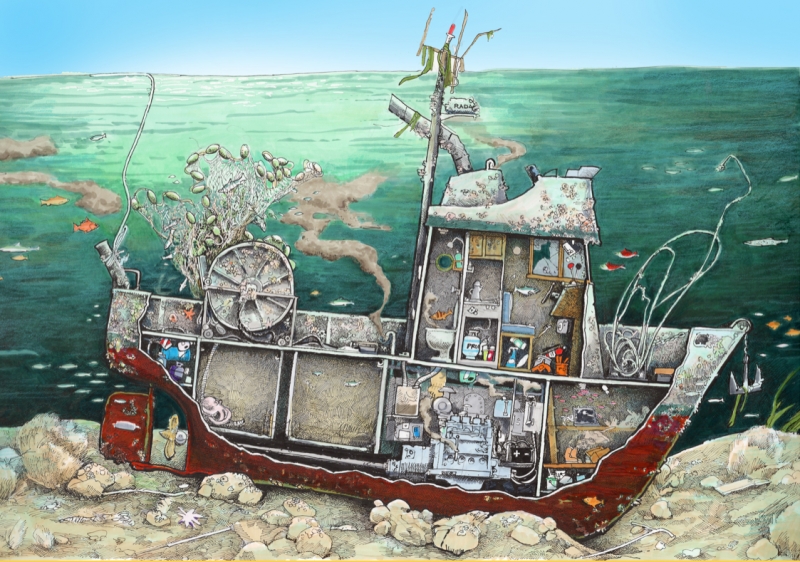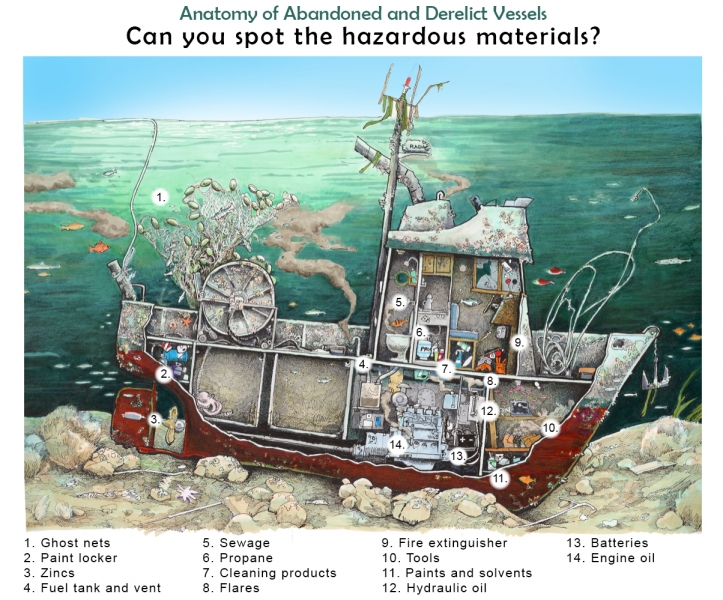During National Safe Boating Week (May 18-24), NOAA’s Office of Response and Restoration is taking a closer look at the anatomy of abandoned and derelict vessels. In this first blog, take a peek at some of the hidden hazards of a sunken vessel.

The waterways and coastlines of the U.S. are a national resource, providing critical habitat, supporting jobs and providing views and recreation, but they are also a dumping ground for sunken, abandoned, and derelict vessels. Abandoned and derelict vessels (ADVs) are a problem in most ports and waterways. Some are dilapidated but still afloat, and others are left stranded on shorelines or hidden just below the surface of the water.
Most derelict and abandoned vessels are the result of chronic processes — rot and rust and deterioration from lack of maintenance, economic obsolescence, etc., with vessels slowly worsening until they sink or become too expensive to repair, and are abandoned. Others are mothballed or are awaiting repair or dismantling. If the owners can't afford moorage and repairs, or if the costs to dismantle exceed the value of the scrap, the owners often dump the boat and disappear. Many vessels end up sinking at moorings, semi-submerged in the intertidal zone, or stranding on shorelines after their moorings fail. These vessels typically lack insurance, have little value, and have insolvent owners.
Another source of abandoned vessels comes from major natural disasters. After large hurricanes, coastal storms, and tsunamis, a large number of vessels of varying sizes, conditions, and types may be damaged or set adrift. Thousands of commercial and recreational vessels required salvage or scrapping after the 2017 hurricane season.
Regardless of the underlying reason for abandonment, these vessels can have significant and diverse effects on the coastal environment, including oil pollution, marine debris, and wildlife entrapment. They become hazards to navigation, illegal dumping of waste oils and hazardous materials, and general public health hazards.
The wreck itself can scour, shade, and physically crush benthic habitats such as corals and sea grasses. As the vessels break into smaller pieces these effects are amplified, and the cumulative footprint of damage becomes much larger than the vessels themselves. In the cutaway of the illustration above, this sunken vessel shows there are a lot of other hazards to consider.
While the vessel is a fairly large piece of marine debris — capable of smothering and scouring the habitat around it — it’s also a source of smaller debris items. Everything that is brought onboard has the potential to do damage to the environment and the marine life around it. From personal items, such as luggage, to the many items necessary for keeping a vessel running, none of these items were meant to end up in a marine habitat.
Apart from the overall debris hazards, many of these items can also be toxic. Each vessel carries materials such as batteries, fuel and other oils, and propane — and the larger the vessel, the more oil and chemicals it can carry.
In the illustration below, take a look at the places where common hazardous materials are found on a typical abandoned or derelict vessel.

Doug Helton, based in Seattle, first saw Tom Crestodina’s artwork at a local boat show. Crestodina is a commercial fisherman from Bellingham, Washington, who began drawing to help describe to his young son about the vessels he worked on. He enjoys showing interesting details about what goes on inside the vessels, as seen above and below the waterline. He is currently working on a book of vessel illustrations. To view more work by Tom Crestodina, visit his website here.
